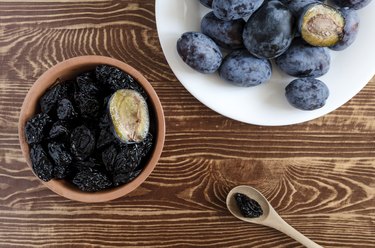
Dried fruit calories are lower than those in many treats, making it a healthier alternative to candy and cakes. However, you still need to watch your portions. Dried mango, banana chips, prunes and other dried fruits boast a lot of sugar and may contribute to weight gain.
Dried Fruit Calories and Nutrients
Video of the Day
Fresh fruits are an important part of any diet. However, sometimes they may be harder to obtain depending on what season you're in. Dried versions of your favorite fruits are a great choice as long as you don't go overboard. These products often taste similar to fresh fruit, but they're more concentrated in sugar.
Video of the Day
According to the Cleveland Clinic, the nutrient content of fresh fruit is the same as that of dried fruit. However, you'll consume more calories because most dried fruit brands contain added sugar. Plus, it's easy to overeat them as their water content has been removed, making the serving size smaller.
Raisins are one of the most popular dried fruits. The USDA lists them as having approximately 85 calories, 1.28 grams of dietary fiber and 18.5 grams of sugar per ounce, which is equal to about 60 raisins. Prunes, or dried plums, provide 418 calories, 12.4 grams of fiber and 66.3 grams of sugar per cup. But you don't have to (and shouldn't) eat an entire cup in one sitting as the calories will add up.
Other popular dried fruits include:
- Dates: 66.5 calories, 1.61 grams of fiber and16 grams of sugar per fruit
- Dried apricots: 314 calories, 9.49 grams of fiber and 69.5 grams of sugar per cup
- Banana chips: 147 calories, 2.8 grams of fiber and10 grams of sugar per ounce
Nutrients in Dried Fruit
Harvard Medical School notes that dried fruits are higher in fiber and antioxidants (especially phenols) than fresh fruit. Diets rich in plant phenols are associated with lower rates of heart disease, several types of cancer and brain disorders. Additionally, this nutrient supports digestive health and may help relieve gas and bloating. Beware, though, that too much fiber may worsen certain digestive disorders.
A June 2013 study published in the _Journal of Food Science _analyzed blood glucose and insulin responses to raisins compared to other foods and snacks. Researchers have found that raisin consumption may reduce triglycerides and bad cholesterol levels. Therefore, it may significantly reduce the risk of developing diabetes or cardiovascular disease.
Some of the study authors are consultants for the California Raisin Marketing Board, so you should take these findings with a grain of salt. Consume raisins in moderation to stay on the safe side.
According to the Dietary Guidelines, the recommended amount of fruit in a 2,000 calorie diet is two cups per day. One half-cup of dried fruit counts as one cup-equivalent of fresh fruit.
Read more: Top 10 Healthiest Fruits and Vegetables
Ways to Incorporate Dried Fruits
Eating dried fruits as a snack isn't the only way you can incorporate them into your diet. Dried food can also be used in creative ways for cooking, which will not only allow you to diversify your meals but also boost your nutrient intake. Here are some ideas you may want to consider:
- Dried fruit is a great addition as a topping. You can add raisins to oatmeal, dried strawberries to cereals or cranberries to salads.
- Use dried fruits as an addition to sauces. Just make sure you rehydrate them before adding them to your dishes.
- Add dried fruits to different types of bread and pastries like raisin bread or cranberry scones. Again, make sure you soak them in water before using them in your recipes.
- Shorten the baking time for oatmeal raisin cookies so the fruits stay nice and plump.
- You can rehydrate your dried fruit in drinks like wine, tea, water or juice.
- Cleveland Clinic: "Enjoy Dried Fruit Benefits"
- USDA: "Raisins, dark, seedless (Includes foods for USDA's Food Distribution Program)"
- International Foundation for Gastrointestinal Disorders: "Dietary Fiber"
- Harvard Health: "Is Eating Dried Fruit Healthy?"
- Dietary Guidelines 2015-2020: "A Closer Look Inside Healthy Eating Patterns"
- U.S. Department of Agriculture: "Dates, Medjool"
- U.S. Department of Agriculture: "Apricots, Dried, Sulfured, Uncooked"
- U.S. Department of Agriculture: "Snacks, Banana Chips"
- Journal of Food Science: "Raisin Consumption by Humans: Effects on Glycemia and Insulinemia and Cardiovascular Risk Factors"